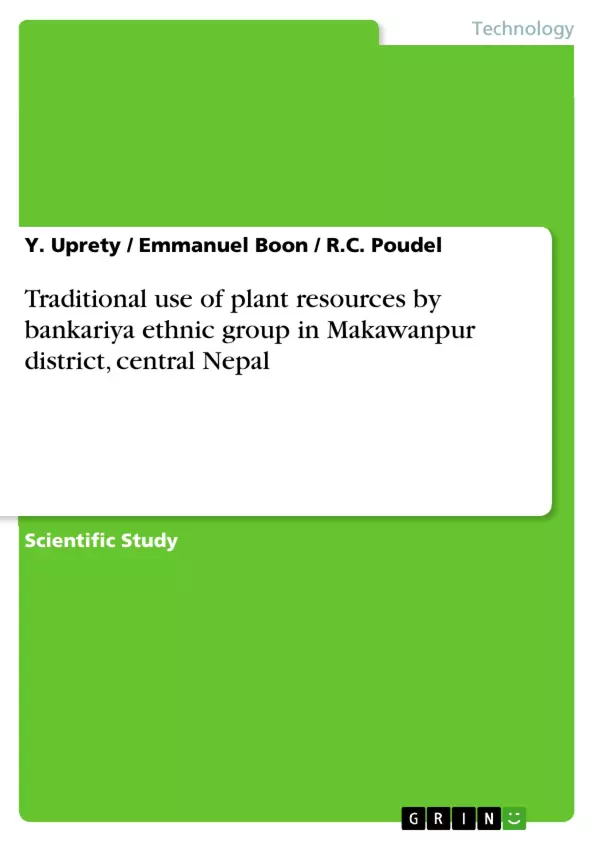An ethonobotanical study was conducted to document the traditional use of plants and to find out the potential economic value of plants used by the indigenous ‘Bankariya’ people of Central Nepal. Personal interviews and group discussions were conducted to gather information on the indigenous knowledge of this
ethnic group. A checklist of ‘categories of plant use’ was developed and used to identify, categorize and document plant species in the Twanrakhola community. Altogether, 109 plant species belonging to 49 families and 84 genera used for a wide range of purposes in the community are recorded. The people are highly
dependent on forest and forest products. Because of their long experience with forests, the ‘Bankariya’ people have acquired rich knowledge about the utilization of plant resources in various ways. The Twanrakhola community harbours a high diversity of medicinal plants and wild edible plants. Despite the gradual
economic and socio-cultural transformation in the life style of the community members because of globalisation, the Bankariya people still possess substantial knowledge of plants and their uses. Sustainable harvesting of and trade in medicinal and wild edible plants could be a significant source of subsistence and income generation for the local population.
Inhaltsverzeichnis (Table of Contents)
- Abstract
- Introduction
- Research Problem, Objectives and Guiding Hypothesis
- Materials and Methods
- Results
- Ethnobotanical Documentation
- Diversity of Plant Species
- Category of Ethnobotanical Plant Species
- Plants and Habit Categories
- Plants of Medicinal Plants Used
- Discussion of Results
- Medical Uses of Plants
- Plants as a Source of Food
- Plants and Livestock Farming
- Miscellaneous Plant Species
- Decline in Traditional Ethnobotanical Knowledge
- Conclusion
- Acknowledgements
Zielsetzung und Themenschwerpunkte (Objectives and Key Themes)
This research aims to document the traditional use of plants by the indigenous 'Bankariya' people in Central Nepal and to explore the potential economic value of these plants. The study utilizes ethnobotanical methods, including personal interviews and group discussions, to gather information about the local community's knowledge of plant use.
- Traditional knowledge of plant use by the 'Bankariya' people
- Biodiversity and sustainable use of plant resources
- Potential economic value of medicinal and wild edible plants
- The impact of socio-cultural transformation on traditional knowledge
- Livelihood enhancement and community development
Zusammenfassung der Kapitel (Chapter Summaries)
The research begins with an introduction highlighting the importance of ethnobotanical research and documenting indigenous knowledge for the conservation and sustainable use of plant resources. It then delves into the research problem, objectives, and guiding hypothesis, emphasizing the need to document traditional knowledge of plant utilization before its potential extinction. The materials and methods section outlines the field study conducted in the Twanrakhola community, detailing the data collection techniques employed and the identification of plant species. The results section presents a detailed analysis of the documented plant species, including their diversity, categories, and various uses. The discussion of results focuses on the medical, food, livestock farming, and miscellaneous uses of plants, highlighting the significance of these resources for the 'Bankariya' people's livelihoods. The chapter also explores the potential economic value of medicinal and wild edible plants and the decline in traditional ethnobotanical knowledge due to socio-cultural transformations. Finally, the conclusion emphasizes the importance of preserving and promoting traditional knowledge for sustainable development and biodiversity conservation.
Schlüsselwörter (Keywords)
This research centers on the 'Bankariya' people, indigenous knowledge, plant use, ethnobotany, biodiversity, sustainable development, medicinal plants, wild edible plants, Nepal, and livelihood enhancement.
- Quote paper
- Y. Uprety (Author), Prof. Dr. Emmanuel Boon (Author), R.C. Poudel (Author), 2008, Traditional use of plant resources by bankariya ethnic group in Makawanpur district, central Nepal, Munich, GRIN Verlag, https://www.grin.com/document/91869



